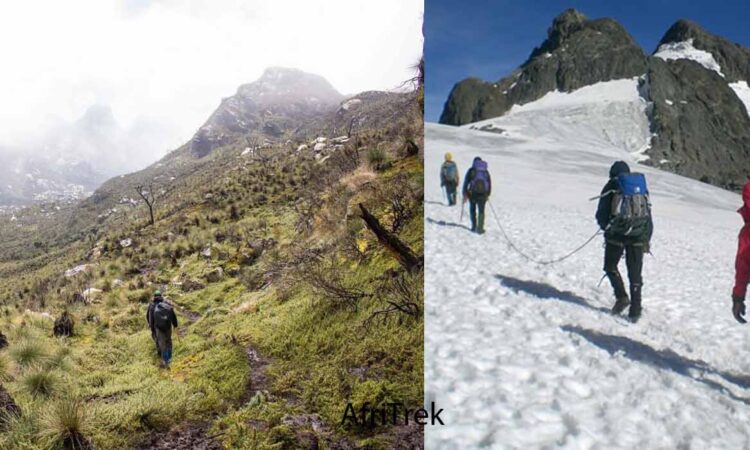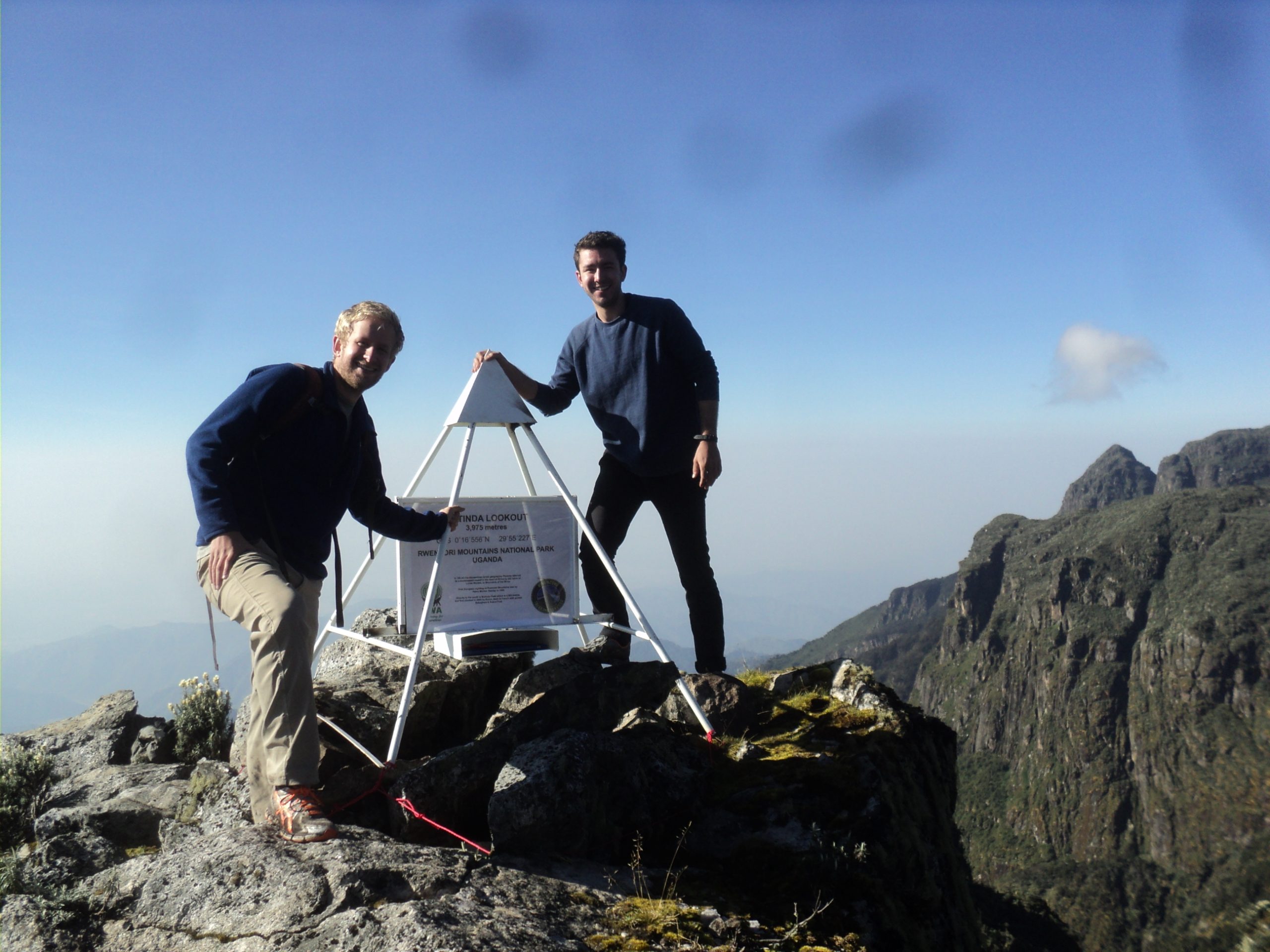6 Days Mount Rwenzori Hiking Safari : The journey begins at Trekkers Hostel Kyanjuki, 12 kilometers from Kasese town, and continues via the Kilembe Copper Mines. It’s best to start around 8.30 a.m. Meet your guides and porters for a briefing and a cup of coffee, then begin your journey by walking 2.2 kilometers to the UWA rangers station at 1,727 meters. There are several plant species and animals, including the L’Hoest monkey, which is one of the Bukonzo cultural icons, and you may hear wild chimpanzees in the background.

Highlights for 6 Days Mount Rwenzori Hiking Safari.
Day 1: Pickup from Kampala/Entebbe and Transfer to Kasese
Day 2: Hike to Sine Camp
Day 3: Sine Camp- Mutinda Camp
Day 4: Mutinda Camp – Kiharo Camp
Day 5: Descend Back to Base
Day 6: Transfer Back to Entebbe
Detailed Itinerary for 6 Days Mount Rwenzori Hiking Safari.
Day 1: Pickup from Kampala/Entebbe and Transfer to Kasese
A guide/driver from Explore Rwanda Tours will pick you up and take you to Kasese before continuing on to the Rwenzori Mountains National Park. Enjoy the scenery along the route. As you approach Kasese, you will be astounded by the countryside, tea plantations, and breathtaking vistas of the Rwenzori Mountains.
You will make a photo stop at the equator crossing before heading to Mbarara for lunch. You will also go shopping in this city if you need anything while up the mountain. Once in Kasese, transfer to your hotel for dinner and stay.
Day 2: Hike to Sine Camp
After an early breakfast, we travel to the park entry and begin the walk after a briefing at 1,450 meters. We trek to Sine Hut at 2,596 meters, gaining 1,146 meters in elevation.
We begin by going up the valley floor, past the tall forest trees of the Afro-Montane Forest Zone. This is a gradual ascent with many of birds and the potential to observe blue monkeys scampering through the bush. At times, visitors may observe groups of 15 to 20 black and white Colobus monkeys swinging among the treetops.
There are occasional sightings of the L’Hoest monkey, which is one of the Bukonzo cultural icons and is protected by the virtue of the King or Omusinga, or you may hear a wild chimp in the distance. There is a diverse range of plant species, including forest trees, bamboo thickets, low shrubs, flowers, and mushrooms, as well as many moss and lichen-covered vines hanging from the big trees, which adds to the overall beauty. Dinner and overnight stay at your camp.
Day 3: Sine Camp- Mutinda Camp
After a nice breakfast, hiking begins at 8.30 a.m. and takes you through the Bamboo-Mimulopsis Zone, which is a difficult ascent with numerous high stairs. During the wet season, the bamboo zone becomes muddy and slippery, making progress slow. However, the environment and forest are stunning as you ascend 551 meters in elevation and 1.8 kilometers to Kalalama Camp at 3,147 meters in the Heather-Rapanea Zone, where you may pause and have a short cup of tea or coffee before continuing on to Mutinda Camp.

The route meanders up and over numerous tiny knolls along a ridge top, then lowers down the valley side before going back up, crossing several small streams and passing near to moss-covered waterfalls. You then slowly climb along the side of a lovely mossy river that cascades down over the rocks beneath the Giant Heather trees, their trunks coated in green moss and old man beards (Usnea lichen) hanging from the branches.
Dinner and overnight stay at Mutinda Camp.
Day 4: Mutinda Camp – Kiharo Camp
We begin the day by trekking up a Rocky River bed, then across a lengthy stretch of bogs, before ascending to the top of a big waterfall. We built boardwalks in the higher region and want to extend them as soon as possible. We then turn right and climb a little before descending through Hunwicks Pass, a new trail that passes through two high peaks known as Twin Peaks, where, in addition to the possibility of seeing a Hyrax or Red Diker, we can see various species of hawks and eagles nesting high on the cliff faces.
At the bottom, you’ll travel through a swamp filled with lobelia plants before continuing on to Kiharo Camp over towering heather trees and big moss-covered boulders. A large waterfall pouring down moss-covered rocks is about 200 meters from the camp and well worth visiting.
Following a 387m elevation increase and a 545m fall, the distance to the overlook is 1.9km, followed by roughly 5km to Kiharo camp.
Dinner and overnight stay at Kiharo camp.
Day 5: Descend Back to Base
The route down the Nyamwamba Valley is primarily downhill and offers wonderful vistas. The moss-covered rocks beside the river, flowing waterfalls, vast valleys, and forests are among the Rwenzori Mountains‘ greatest features.
A few kilometers from Kiharo Camp, the trail curves to the right and follows the river. As you go down the river, you may notice a Duiker calmly eating in little clearings. If you prefer, you may stroll down the river, jumping across the rocks along the way.
After crossing a tiny brook. The forest along this part is spectacular and alive, with numerous birds, monkeys, duikers, and hyrax. A spectacular trip followed a 1,710 meters’ elevation decrease over a distance of 14.6km. Later, return to your accommodation in Kasese for dinner and overnight stay.
Day 6: Transfer Back to Entebbe
After breakfast, check out of your accommodation and proceed to Kampala. Via Mubende, you will most likely arrive in Kampala in the evening and stay overnight at your hotel or be taken to Entebbe International Airport.
End of 6 Days Mount Rwenzori Hiking Safari


